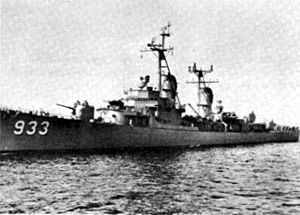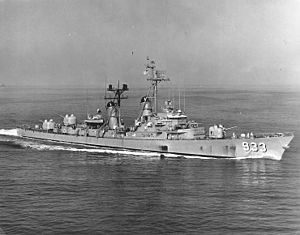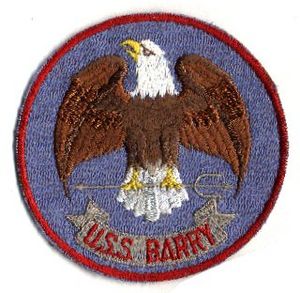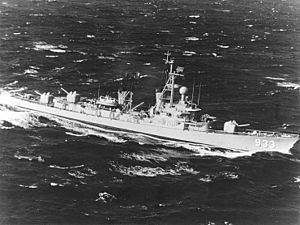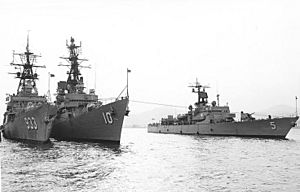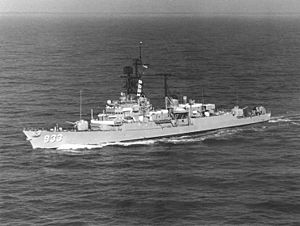USS Barry (DD-933) facts for kids
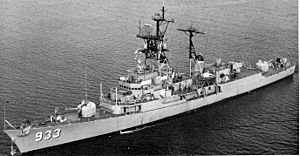
Barry, 1971
|
|
Quick facts for kids History |
|
|---|---|
| Name | Barry |
| Namesake | John Barry |
| Ordered | 15 December 1952 |
| Builder | Bath Iron Works |
| Laid down | 15 March 1954 |
| Launched | 1 October 1955 |
| Sponsored by | Mrs. Francis Rogers |
| Acquired | 31 August 1956 |
| Commissioned | 7 September 1956 |
| Decommissioned | 5 November 1982 |
| Stricken | 31 January 1983 |
| Fate | Scrapped at Brownsville, Texas, completed by 11 February 2022 |
| General characteristics | |
| Class and type | Forrest Sherman-class destroyer |
| Displacement | 4,050 tons |
| Length | 418 ft 6 in (128 m) |
| Beam | 45 ft (13.7 m) |
| Draught | 19 ft 6 in (5.9 m) |
| Propulsion | 70,000 shp (52.2 MW); Geared turbines, two propellers |
| Speed | 33 knots (61 km/h; 38 mph) |
| Range | 4500 nautical miles (8,300 km) |
| Complement | 337 |
| Electronic warfare & decoys |
5 |
| Armament |
|
The USS Barry (DD-933) was a destroyer in the United States Navy. She was one of eighteen ships in her class, called the Forrest Sherman-class destroyer class. This ship was the third U.S. destroyer named after Commodore John Barry, a hero of the American Revolution.
Barry was put into service in 1956. She spent much of her time sailing in the Caribbean Sea, the Atlantic Ocean, and the Mediterranean Sea. She also played a part in the Vietnam War, where she earned two special awards called battle stars. Another important event in her history was the Cuban Missile Crisis in 1962.
After being taken out of service in 1982, Barry became a museum ship in 1984. She was called "Display Ship Barry" (DS Barry) and was located at the Washington Navy Yard in Washington, D.C.. Visitors could explore parts of the ship and learn about naval history.
However, keeping the ship as a museum became too expensive. Also, a new bridge was planned for the Anacostia River, which would have trapped Barry at the Navy Yard. Because of these reasons, the Navy decided to scrap the ship. Barry left the Washington Navy Yard in May 2016 and was taken to Philadelphia to be taken apart. This process was finished by February 2022.
Contents
- Building and Starting Service
- Early Missions: 1956–1959
- Exploring Europe: 1960–1962
- The Cuban Missile Crisis
- Training and Rescue: 1962–1965
- Service in the Vietnam War
- Global Journeys and Upgrades: 1966–1970
- Mediterranean Home: 1972–1976
- Later Years and Decommissioning: 1977–1982
- Display Ship: 1984–2015
- Final Journey and Scrapping
- Awards and Honors
Building and Starting Service
Barry was built at the Bath Iron Works Corporation in Bath, Maine. Her construction began on March 15, 1954. She was launched into the water on October 1, 1955. Mrs. Francis Rogers, a relative of Commodore John Barry, was her sponsor. The ship officially started service at the Boston Naval Shipyard on September 7, 1956. Commander Isaac C. Kidd, Jr. was her first commanding officer.
Early Missions: 1956–1959
After being commissioned, Barry spent time at the Boston Naval Shipyard. She tested her new electronics, anti-submarine equipment, and guns. In January 1957, she sailed to Guantánamo Bay, Cuba, for more training. During this time, she visited ports in Kingston, Jamaica; Culebra, Puerto Rico; and Santa Marta, Colombia.
The destroyer then traveled through the Panama Canal in February. She made "goodwill" visits to ports in Ecuador, Peru, and Chile. After these visits, she returned to Boston in March 1957.
After some repairs, Barry went on her first trip to Europe in June. She visited St. Nazaire, France, and Lisbon, Portugal. In July, she arrived in Gibraltar and joined the US 6th Fleet. Her duties included escorting aircraft carriers and looking for enemy submarines. She returned to Newport, Rhode Island, in August.
In September, Barry helped a Norwegian freighter that was stuck. She also helped escort the nuclear submarine Seawolf, which carried President Dwight D. Eisenhower. For several months, she continued routine operations, including anti-submarine warfare (ASW) exercises.
In July 1958, a new government took over in Iraq. The president of Lebanon asked the United States for help. President Eisenhower sent Marines to Lebanon. Barry was in the Mediterranean at the time and helped support the Marines ashore. She patrolled the Lebanese coast and escorted carriers. Later that year, she received a new bow-mounted sonar system in Boston.
Exploring Europe: 1960–1962
In June 1960, Barry began a summer trip to Northern Europe. She visited Portsmouth, England, and Kiel, Germany. She also went to the Netherlands, Finland, Sweden, Denmark, and Belgium. During this trip, her crew shared information about U.S. naval technology with other navies. She returned to Newport in August.
After more training, Barry went to the Mediterranean in June 1962. She operated with the 6th Fleet for two months. During this time, she saw many Soviet merchant ships sailing from the Black Sea towards Cuba. She returned to Newport in August.
The Cuban Missile Crisis
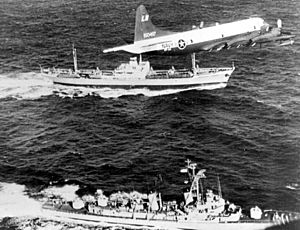
In October 1962, the United States discovered that the Soviet Union was building nuclear missile sites in Cuba. President John F. Kennedy announced a "quarantine" to stop offensive military equipment from reaching Cuba. Barry quickly left Newport on October 22 to join other ships.
She worked as a screening vessel and plane guard for the aircraft carrier Essex. Barry was then sent to watch a Soviet submarine, C-19, keeping it under close surveillance.
Later, Barry was ordered to investigate a Soviet merchant ship. She got close to the ship, identified it as the Metallurg Anosov, and took photographs of its cargo. She followed the merchant ship as it sailed away from the quarantine zone.
Training and Rescue: 1962–1965
After her role in the Cuban Quarantine, Barry returned to Newport in November 1962. For the next six months, she conducted training exercises. In June 1963, she went into the Boston Naval Shipyard for repairs. That summer, she took midshipmen (naval cadets) on a training cruise along the eastern coast of the United States.
In March 1964, Barry received a distress call from the ship Antares, which had a serious fire. Barry's fire and rescue team was the first to arrive and helped put out the blaze after an 18-hour effort. She then participated in a NATO exercise with German destroyers.
In September 1964, Barry sailed for a three-and-a-half-month deployment in Europe and the Mediterranean. She took part in NATO exercises in the Norwegian Sea and even crossed the Arctic Circle. She visited several ports, including Valencia, Spain, and Naples, Italy. She returned to Newport in December.
In 1965, Barry went to the Caribbean for training. In June, she helped as a recovery ship for the Gemini 4 space mission. Later that year, she prepared for her first deployment to Vietnam. She was the flagship for a group of destroyers from the U.S. Atlantic Fleet heading to Vietnam.
Service in the Vietnam War
Barry traveled through the Panama Canal in October 1965. After visiting Japan, she arrived in the Philippines in November. She then sailed to the South China Sea to join Task Group 77.7, which included the aircraft carrier Enterprise.
Off the coast of South Vietnam, Barry protected the carrier during airstrikes against enemy positions. In December, she was sent to the South Vietnamese coast for gunfire support. She steamed up the Saigon River and fired her 5-inch (127 mm) guns at enemy supply points and trenches. She also supported ground troops in the Mekong Delta region.
Barry continued to screen the Enterprise as it launched strikes against North Vietnamese targets. She helped protect the carrier during bombing campaigns in December 1965 and January 1966.
In January 1966, Barry received orders for "special operations" in South Vietnam. She provided naval gunfire support for the landing of 5,000 Marines in Quảng Ngãi province. This was a large combat assault called Operation "Double Eagle." Barry fired on enemy positions and helped patrol the coast.
In February, she supported 1st Cavalry and ARVN units in Operation "Masher-White Wing." She fired many rounds against enemy positions. After this, she went to Hong Kong for a break.
For her service in the Vietnam War, Barry was awarded two battle stars.
Global Journeys and Upgrades: 1966–1970
After leaving Hong Kong, Barry sailed to Penang, Malaysia, and then to Cochin, India. In March, she traveled through the Suez Canal and visited Naples, Italy, and Barcelona, Spain. She returned to Newport in April 1966, having sailed all the way around the world.
After some training, Barry entered the Boston Naval Shipyard in July for a special project. She was fitted with a new Mk 86 fire control system, which included an advanced radar. She also received a new sonar transducer. After testing this new equipment, she went to the Caribbean for shore bombardment evaluations.
In January 1967, Barry began a major overhaul and anti-submarine warfare (ASW) conversion. She was taken out of service for a while. During this time, she received a new variable depth sonar (VDS), an ASROC launcher (for anti-submarine rockets), a new combat information center, and an enclosed bridge. She was put back into service in April 1968.
In May 1969, Barry went on a six-week cruise in the Caribbean for training. Later, she deployed to the North Atlantic for four months, participating in NATO exercises. She visited cities like Antwerp, Belgium, and Oslo, Norway. In December, she rescued the crew of a helicopter that had crashed.
For the next two years, Barry followed a routine schedule of training, exercises, and port visits. In 1972, she prepared to change her home port to Athens, Greece.
Mediterranean Home: 1972–1976
Barry arrived in Athens, Greece, on September 1, 1972, joining other destroyers. She began intensive operations with the 6th Fleet. This included NATO exercises with Greek and Turkish ships, goodwill visits to various countries, and anti-submarine training.
In July 1973, Barry received an upgrade to her sonar system. In October, during the Yom Kippur War (a conflict between Arab nations and Israel), she was quickly prepared for deployment. She served as an anti-submarine screen ship for a Marine landing battalion near the Suez Canal. In November, a Marine helicopter crashed onto Barry's ASROC deck during a routine flight. No one on Barry was hurt, and two of the three helicopter crew members were rescued.
In 1974, Barry continued patrol operations. During the Cyprus Crisis, she helped evacuate military personnel from Athens to Naples, Italy. She then spent a month on tense operations in the Aegean Sea.
In July 1975, after 36 months in Greece, Barry left Athens. She sailed back to Philadelphia, arriving on August 20. She spent the rest of the year in port, except for participating in the 200th Navy birthday celebration in New York City. In February 1976, she entered the Philadelphia Naval Shipyard for a major overhaul.
Later Years and Decommissioning: 1977–1982
Barry remained in the shipyard until February 1977. Her homeport was then changed to Naval Station Mayport, Florida. She began training exercises and then deployed to the Mediterranean for the fifth time. In November, she helped rescue two crew members from an aircraft that crashed near the carrier America.
In January 1978, Barry shadowed Soviet ships, including the Kiev, in the Eastern Mediterranean. She observed their operations before returning to Italy. She then participated in more NATO exercises off Sicily and Spain. In August, she sailed for a northern European cruise, taking part in exercises like "Common Effort" and "Northern Wedding." She visited Copenhagen, Denmark, and Helsinki, Finland. She returned to Mayport in November.
In 1979, Barry conducted anti-submarine warfare and naval gunfire support operations. She then prepared for another Mediterranean deployment. She visited Tunis, Tunisia, and Monaco. In June, she sailed through the Suez Canal to Djibouti and then to Karachi, Pakistan. Due to events in Iran, Barry was sent to the Persian Gulf to support American personnel and reassure friendly countries. She patrolled the Persian Gulf and the Straits of Hormuz. She returned to Mayport in September.
In January 1980, Barry's homeport was changed to Boston, and she entered the Bethlehem Steel Shipyard for a year-long overhaul. Her engineering plant, electronics, and weapons systems were extensively repaired. She began her shakedown in March 1981, working to rejoin the fleet. She was then ordered to prepare for a Middle East deployment.
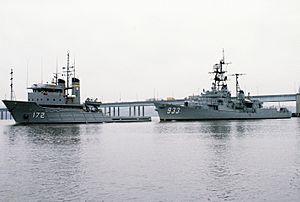
Barry sailed for the Middle East in November 1981, transiting the Suez Canal. She joined an Amphibious Readiness Group and helped escort ships through the Bab el Mandeb Straits. She then joined a battle group for Operation "Bright Star '82," acting as a screen and gunfire support ship. She visited Mombasa, Kenya, and continued patrols in the Persian Gulf until March 1982. She returned to Newport in April.
In the following months, Barry's schedule was lighter. She supported the "Tall Ships '82" race and hosted the Italian cruiser Duilio. As part of a destroyer replacement program, Barry began her final preparations for decommissioning on September 1. On November 5, 1982, Barry was officially taken out of service. She was then towed to the Inactive Ship Facility at the Philadelphia Naval Shipyard.
Display Ship: 1984–2015
After Barry was decommissioned, retired Admiral Arleigh Burke suggested that a U.S. Navy display ship be placed at the Washington Navy Yard. The Navy chose Barry. She was towed from Philadelphia and arrived at the Washington Navy Yard on November 18, 1983.

After volunteers helped repaint the ship and set up museum displays, Barry opened to the public as Display Ship Barry (DS Barry) in 1984. She was a popular attraction for visitors and school groups. In 1990, 500,000 people visited her. She often hosted retirement ceremonies for Navy officers. She also appeared in the background of some television shows, like NCIS.
Final Journey and Scrapping
The number of visitors to DS Barry started to decrease after 1990. By 2015, only about 10,000 people visited each year. Although her hull was still in good condition, the ship needed about $2 million in repairs. The U.S. Navy decided this was too expensive for the low number of visitors.
Meanwhile, the city of Washington, D.C., planned to replace the Frederick Douglass Memorial Bridge with a new, fixed bridge. This new bridge would have trapped Barry in the Anacostia River. Because of these reasons, the U.S. Navy decided to close DS Barry and have her scrapped before the new bridge was built.
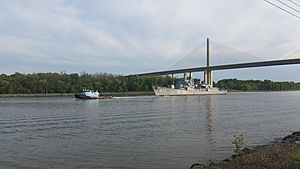
During the summer of 2015, people from the Naval History and Heritage Command removed artifacts from the ship for display elsewhere. A special ceremony for the ship's departure took place on October 17, 2015.
On May 7, 2016, DS Barry's masts were cut down. She was then towed from the Washington Navy Yard by tugboats. As she was towed down the Anacostia River, a Washington, D.C., fireboat saluted her with water cannons. Music was played from ashore. Barry made a 50-hour journey to the inactive ship facility at the Philadelphia Naval Shipyard. There, she was prepared to be sold for scrapping. The scrapping process was completed by February 11, 2022.
Awards and Honors
Barry received several awards for her service. These include:
| Navy Expeditionary Medal | National Defense Service Medal | Vietnam Service Medal | ||||||
| Vietnam Campaign Medal | Meritorious Unit Commendation | Armed Forces Expeditionary Medal |


